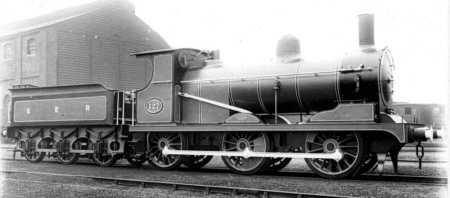The Class J14 (GER Class N31) 0-6-0 Locomotives

James Holden continued to build the Worsdell J15 0-6-0 until 1892. In an attempt at greater standardisation in 1893, he altered the design to use the cylinders from the GER Class T19 2-4-0. A significant change was that the valve chests were now below the cylinders instead of between. The new locomotives were given the the classification of N31 (LNER J14). Between 1893 and 1898 a total of 81 locomotives were built in nine batches. The class also included No. 127 which was built in 1888 as a two-cylinder compound, but rebuilt as an N31 in July 1895.
The new locomotives resembled the J15s but the boiler was positioned 7.5in higher to clear the new cylinders. Unlike the very successful J15s, the J14s were a disappointment. The position of the valves and steam chest immediately below the cylinders interfered with the airflow to the ashpan. The steam chests often became "water logged". Symptoms included a tendency to prime badly, and a slow response to regulator changes. The sluggish J14s were given the ironic nicknames of Swifts and Waterburies.
The first 31 J14s were built with 140psi boilers, but the last 50 were built with 160psi boilers. The boilers on all but the last ten J14s were standard with the E4 2-4-0s, F3 2-4-2Ts, D13 4-4-0s, and J15s. The last batch of ten J14s were fitted with a new boiler design that used two telescopic rings, instead of two butt-jointed rings. This new boiler had a reduced number of tubes and heating surface. By 1908, 21 of the early J14s had been rebuilt with the telescopic boiler. A second change in the boiler design appeared in 1907. This second design changed the layout of the tubes with a final result of 242 tubes and 1164.7 sq.ft. heating surface. All of the J14s that survived into LNER ownership had either the 1898 telescopic boiler, or the 1907 242 tube boiler.
Many of the J14s were built with unbalanced cast iron wheels, whilst others had balanced steel wheels. Both wheel types had the same number of spokes and are hence indistinguishable in photographs. Twenty J14s had Westinghouse air brakes fitted for excursion traffic, and as a rule were all fitted with steel wheels.
The J14s were initially used to haul coal to London via March and Peterborough. During World War 1, many were loaned to the London North Western Railway (LNWR). By Grouping (1923), the surviving J14s had been relegated to local pick-up goods and yard duties. Allocations were divided between Stratford, Colchester, Parkeston, Ipswich, Sudbury, Norwich, Yarmouth, King's Lynn, Peterborough, and March.
Due to their poor performance, construction switched from the J14s back to the older J15 design in 1899. Withdrawals started in 1908, as increasing traffic and larger goods engines were introduced. Withdrawals were quick for such new locomotives, and only eighteen survived into LNER ownership. The LNER withdrew the last J14s in 1925.
Technical Details
| Cylinders (x2): | (inside) | 17.5x24in. |
| Motion: | Stephenson | Slide Valves |
| Boiler: | Max. Diameter: | 4ft 4in |
| Pressure: | 160psi | |
| Diagram No.: | 32 | |
| Heating Surface: | Total: | 1164.7 sq.ft. |
| Firebox: | 100.9 sq.ft. | |
| Tubes: | 1063.8 sq.ft. (242x 1.625in) | |
| Grate Area: | 18 sq.ft. | |
| Wheels: | Coupled: | 4ft 11in |
| Tender: | 4ft 1in | |
| Tractive Effort: | (@ 85% boiler pressure) | 16,942lb |
| Wheelbase: | Total: | 35ft 5in |
| Engine: | 16ft 1in | |
| Tender: | 12ft 0in | |
| Weight (full): | Total: | 69 tons 12cwt |
| Engine: | 38 tons 19cwt | |
| Tender: | 30 tons 13cwt | |
| Max. Axle Load: | 14 tons 8cwt |
Preservation
The last J14 was withdrawn in 1925, and none survived into preservation.
Models
I am not aware of any models of the J14.
Acknowledgements
Thank you to Barry Heath for some of the above information.
Thank you to Malcolm Peirson for the photograph of GER No. 127.